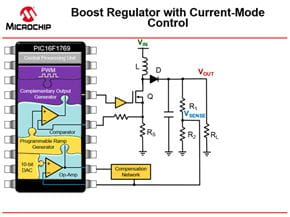The world of embedded microcontrollers is a world in transition. For years, the 8-bit MCU was so widely incorporated that it spawned a plethora of existing designs and applications, but since its rollout, much has changed.
Once the sole standard, the 8-bit has since had to move over to make room for the addition of the 32-bit microcontroller. 32-bit MCUs offered designers new potential. On its face, the 32-bit MCU presents more processing power, which offers the ability to add new potential functions. Larger pin count options and bigger memories are also typically available on 32-bit parts. The larger registers on 32-bit MCUs simplify math operations all while offering more complexity in development, code, and tools. But as with any new tool, there are tradeoffs. The more that developers worked with 32-bit MCUs, the more attractive certain aspects of 8-bit MCUs looked.
32-bit code can end up larger and more complex than 8-bit code, and it often needs more on-board memory to house the greater amount of instructions it requires. Increasingly more complex compilers and development tools are required in order to support the more complex devices that are powered by 32-bit MCUs. The increased functionality of 32-bit is there for programmers, but only if they’re able to code the multi-instruction sequences that are necessary to utilize the full depth and memory and I/O advances. And while it’s true that 32-bit development boards are able to feature more functionality to show off more complex parts, they’re also typically more expensive.
On the other hand, 8-bit processors are often easier to use, and their design and application and code have been extensively documented and diagrammed. The volume of existing knowledge behind an 8-bit MCU removes a lot of guesswork and speeds up development.
Furthermore, you can typically achieve lower active power usage in an 8-bit part, which means longer battery life and lower overall project power use, which translates to lower costs. So despite the advantages of 32-bit, It’s not hard to see why some embedded designers may be looking towards 8-bit for a number of applications.
The Microchip 8-bit Core Independent Peripheral (CIP) Advantage
Microchip has been developing Core Independent Peripherals (CIPs) to expand the capability of the 8-bit MCU to fit the needs of modern embedded applications. CIPs are intelligent peripheral blocks that surround the 8-bit PIC MCU core, allowing for increased functionality without taxing the MCU’s core processor. These peripherals are designed to reduce system complexity by eliminating the need for additional code and external components. By offloading timing-critical and core-intensive functions from the CPU, Core Independent Peripherals allow it to focus on other critical tasks within the system. CIPs enable system performance that is far beyond what a typical 8-bit MCU can offer, while simplifying the design experience and reducing memory requirements.
Below is a list of key categories of Core Independent Peripherals. There are over twenty peripherals that can be used standalone or that can be combined with each other to create the desired function.

Because of their flexibility, interconnectivity, and low power, CIPs enable 8-bit PIC MCUs to suit a wide range of applications, from switching power supplies to IoT applications. Add to this the fact that CIPs can be set up graphically using Microchip’s MPAB Code Configurator (MCC) plugin, and it’s easy to see why the stage is set for fast innovation. In addition, software libraries such as LCD control, Touch sensing, and Ethernet communication are all just a few clicks away.
Here’s an example of the kind of reduction in complexity that CIPs can provide. Figure A shows the software and hardware componentry required for a boost regulator with current-mode control when the design doesn’t incorporate CIPs. Figure B shows a more simplified board as a result of CIPs on the chip.
Figure A:


In the end, embedded designers need to carefully consider their project parameters. Is getting the top end performance no matter the cost really what your system needs, or is it better to craft a solution that gets the job done efficiently and cost-effectively?
32-bit MCUs are capable of a lot. In fact, in many instances, they may be capable of much more than is really needed for your application. Using 32-bit power regardless of whether or not your application may really need it is like taking a Ferrari to the corner store: It’ll get you there, but there may be a more efficient and economic way. 8-bit systems can offer your design efficiency advantages. Far from being left in the past, the 8-bit MCU is still full of life, especially with the addition of Microchip CIPs.
If your system will work well with an 8-bit MCU - and many more will, with the addition of Microchip CIPs - there's no need to give up the existing expertise, extensive knowledge library, and vast product base that 8-bit can offer.
Discover the products in Microchip's PIC16F1769 family of microcontrollers.

